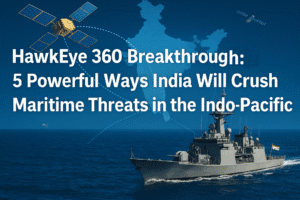HawkEye 360 Breakthrough: 5 Powerful Ways India Will Crush Maritime Threats in the Indo-Pacific
The U.S. has approved a $131 million sale of HawkEye 360’s advanced satellite technology to India, empowering its Navy to detect “dark vessels” that disable tracking systems to evade surveillance. By triangulating radio frequency (RF) signals from low Earth orbit satellites, the system identifies illicit activities like smuggling, illegal fishing, and piracy—even when ships switch off transponders. This bolsters India’s maritime domain awareness, critical for safeguarding strategic Indo-Pacific waterways.
Integrated with India’s existing P-8I aircraft and SeaVision software, the technology enhances real-time analytics and strengthens the Quad alliance’s vision for a transparent, rules-based maritime order. The deal underscores deepening U.S.-India defense ties, countering covert threats while addressing China’s growing influence. As part of the Quad’s Indo-Pacific Maritime Domain Awareness initiative, it also promotes regional stability through shared intelligence and improved crisis response, marking a leap in India’s role as a net security provider.

HawkEye 360 Breakthrough: 5 Powerful Ways India Will Crush Maritime Threats in the Indo-Pacific
In a significant boost to India’s maritime security, the U.S. has approved a $131 million sale of cutting-edge HawkEye 360 technology to the Indian Navy. This deal, sanctioned under the Quad alliance’s broader Indo-Pacific strategy, equips India with advanced tools to detect clandestine activities at sea, from illegal fishing to smuggling—addressing a critical gap in monitoring “dark vessels” that evade traditional tracking systems.
The HawkEye 360 Advantage: Beyond Conventional Surveillance
HawkEye 360, a Virginia-based geospatial analytics firm, operates a unique constellation of low Earth orbit (LEO) satellites that detect and map radio frequency (RF) signals emitted by ships, radars, and communication devices. Unlike the Automatic Identification System (AIS)—a standard tool for tracking vessel movements—this technology identifies ships even when they disable their AIS transponders, a tactic often used for illicit activities. By clustering three satellites to triangulate signals, HawkEye 360 pinpoints the location, type, and patterns of RF emissions, offering real-time insights into suspicious behavior.
For India, this means enhanced maritime domain awareness (MDA) across strategic waterways. The Navy’s existing infrastructure, including P-8I patrol aircraft and Sea Guardian drones, will now integrate HawkEye’s SeaVision software. This fusion enables automated analytics to flag vessels with inconsistent AIS data, correlate unidentified RF activity, and monitor high-risk zones like the Indian Ocean Region (IOR)—a hotspot for piracy, trafficking, and unauthorized resource exploitation.
Why “Dark Vessels” Threaten Regional Security
Maritime “dark zones” emerge when ships disable AIS to mask movements, often to engage in illegal fishing, smuggling, or territorial incursions. Traditional surveillance struggles to track these vessels, creating blind spots. For instance, China’s fishing fleets have repeatedly faced accusations of operating covertly in disputed waters, depleting fish stocks and undermining coastal states’ sovereignty.
HawkEye 360’s RF detection disrupts this opacity. By capturing electronic emissions—such as radar pulses or radio communications—the system identifies vessels regardless of AIS status. During trials, similar technology exposed unauthorized shipping routes in the South China Sea and North Korean fuel transfers evading sanctions. For India, this capability is pivotal in safeguarding its 7,500 km coastline and Exclusive Economic Zone (EEZ), while curbing transnational crime networks.
Quad Collaboration and Strategic Posturing
The sale underscores deepening U.S.-India defense ties and aligns with the Quad’s Indo-Pacific Maritime Domain Awareness (IPMDA) initiative, launched in 2022 to promote a “free and open” region. In 2024, the Quad expanded IPMDA to the IOR, leveraging commercial satellite data to empower partners like India, Japan, and Australia in monitoring climate risks and hostile activities.
HawkEye’s integration with India’s Information Fusion Centre (IFC-IOR), established in 2018, will streamline data-sharing with Quad allies and regional navies. This collaboration not only strengthens India’s role as a net security provider but also counters China’s growing naval footprint. As Admiral R. Hari Kumar (Retd), Chief of Naval Staff, noted earlier this year, “Unified MDA is vital to deterrence—it transforms ambiguity into actionable intelligence.”
A Game Changer for Regional Stability
Beyond hardware, the deal includes training, software enhancements, and U.S. technical support, ensuring the Navy maximizes the system’s potential. Enhanced MDA will empower India to:
- Enforce maritime laws: Rapidly identify illegal fishing vessels and unauthorized resource extraction.
- Counter trafficking: Disrupt drug and human smuggling routes through real-time RF pattern analysis.
- Bolster disaster response: Monitor SOS signals and coordinate aid during cyclones or humanitarian crises.
As China’s naval ambitions grow, partnerships like this signal India’s commitment to a rules-based maritime order. By merging cutting-edge technology with Quad diplomacy, the HawkEye 360 deal marks a leap forward in securing the Indo-Pacific—a region where transparency at sea is synonymous with stability.
You must be logged in to post a comment.